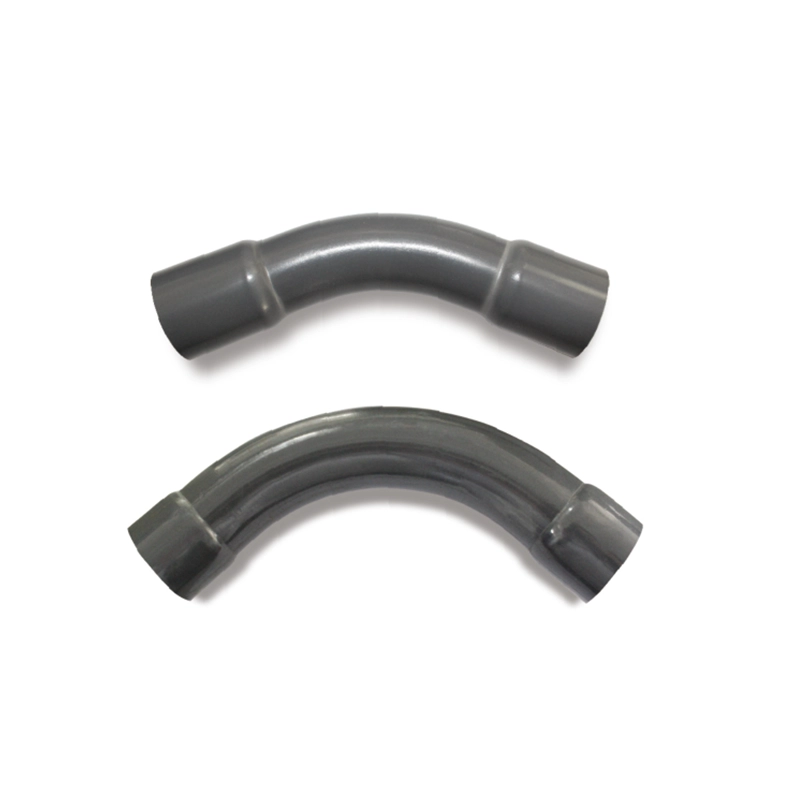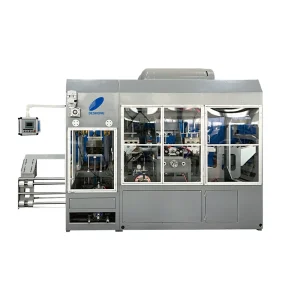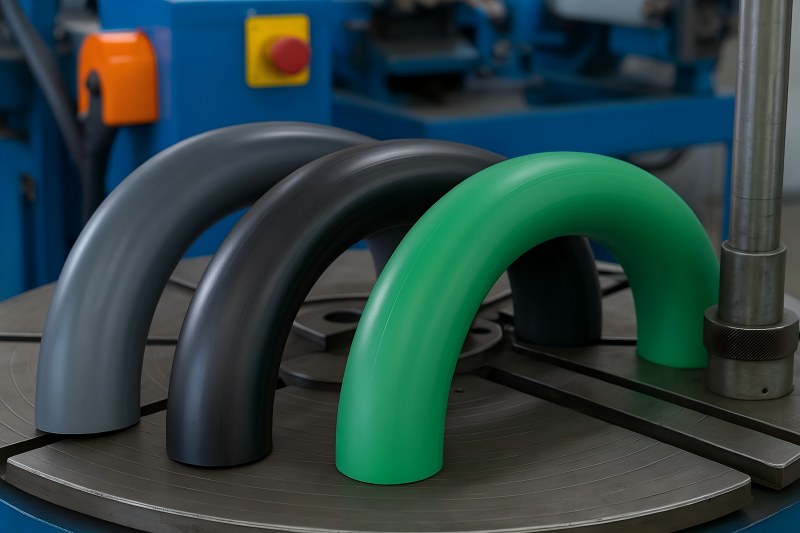Pipe bending is a critical step in the fabrication and installation of fluid transport systems. Whether used in water supply networks, industrial processing, or infrastructure projects, bending pipes with precision machines ensures that pipes follow complex routes without compromising flow, strength, or sealing performance.
However, the success of bending depends heavily on material compatibility—how different plastics like PVC (Polyvinyl Chloride), HDPE (High-Density Polyethylene), and PPR (Polypropylene Random Copolymer) respond to heat, pressure, and mechanical stress.
Why Material Compatibility Matters in Pipe Bending
Precision machines can control heating, pressure, and bending angles to a fine degree, but each polymer has its own mechanical and thermal properties. If bending is attempted without considering compatibility, problems such as wall thinning, ovality, wrinkling, or cracking may occur.
Material compatibility ensures:
- Leak-proof performance: Maintaining the original pipe wall integrity avoids weak spots.
- Dimensional accuracy: Correct bending preserves internal diameter and flow efficiency.
- Mechanical reliability: Bends endure long-term stresses from pressure, heat, and loads.
- Cost-effectiveness: Avoiding scrap and rework saves time and money in both manufacturing and installation.
Pipe Materials

PVC (Polyvinyl Chloride)
- Properties: Rigid, high strength, relatively low impact resistance, and sensitive to high heat.
- Applications: Water supply, drainage, irrigation, and electrical conduit systems for diverse applications.
- Behavior in Bending: Softens around 140–160°C, but excessive heat can cause decomposition (releasing HCl gas). Requires precise temperature control.
HDPE (High-Density Polyethylene)
- Properties: Flexible, excellent impact resistance, high chemical resistance.
- Applications: Gas pipelines, water mains, sewage systems, chemical transport.
- Behavior in Bending: Softens around 120–130°C and exhibits good flexibility, but tends to return to its original shape if not cooled properly (spring-back).
PPR (Polypropylene Random Copolymer)
- Properties: High toughness, temperature resistance up to 95°C in applications, and good pressure handling.
- Applications: Hot and cold water supply systems, industrial liquids, HVAC pipelines.
- Behavior in Bending: Softens around 140–160°C. Requires higher forming temperatures than HDPE, but offers good dimensional stability once cooled.
Key Bending Methods with Precision Machines
Heat Bending
- Uses controlled heating (infrared, hot air, or electric heaters) to soften pipes.
- Pipe is bent around a mandrel or forming die to ensure shape accuracy.
- Common for PVC, HDPE, and PPR.
Cold Bending
- Possible only for flexible plastics like HDPE in large diameters.
- Limited angles and radii.
Induction Bending
- High-frequency induction heaters soften a localized pipe section before bending.
- Used for tight bends requiring precise control.
CNC Bending Machines
- Provide automated bending with computer-controlled parameters.
- Reduce error margins and ensure consistent production quality.

Comparative Data of Material Behavior in Bending
| Property | PVC | HDPE | PPR |
| Softening Temp (°C) | 140–160 | 120–130 | 140–160 |
| Elasticity | Low (rigid) | High (flexible) | Moderate |
| Spring-back Tendency | Low | High | Moderate |
| Pressure Resistance | Good | Excellent | Very Good |
| Heat Resistance | Fair | Good | Excellent |
| Suitability for Cold Bending | No | Yes (limited) | No |
| Typical Bend Radius (times pipe diameter) | 8–10D | 20–25D | 10–12D |
Machine Parameters for Precision Bending
Heating
- PVC: Maintain 150°C ± 5°C. Overheating risks decomposition.
- HDPE: Heat at 125°C ± 5°C for flexibility. Prolonged heating causes sagging.
- PPR: Heat at 150–160°C for uniform softening.
Cooling
- Controlled air or water cooling to fix bend geometry.
- Rapid cooling may cause stress; gradual cooling avoids cracks.
Mandrel Use
- Essential for PVC and PPR to prevent flattening.
- HDPE may be bent without mandrels at larger radii, but mandrels improve accuracy.
Common Defects and Prevention
| Defect | Cause | Prevention |
| Ovality (flattening) | Insufficient mandrel support; improper heating | Use mandrel, uniform heating |
| Wall thinning | Small bend radius | Increase bend radius; adjust heating |
| Wrinkling | Overheating, excessive compression | Optimize temperature and bending speed |
| Cracking (PVC) | Excessive temperature or stress | Maintain strict heating control |
| Spring-back (HDPE) | Inadequate cooling after bending | Extend cooling period; over-bend slightly |
Energy and Productivity Considerations
Precision machines provide controlled environments, improving both quality and efficiency.
Example Productivity Data (per 8-hour shift):
| Pipe Material | Avg. Bend Time per Piece | Scrap Rate (Manual Bending) | Scrap Rate (Precision Machine) |
| PVC Ø100mm | 3–4 min | 12% | 3% |
| HDPE Ø160mm | 4–5 min | 15% | 4% |
| PPR Ø50mm | 2–3 min | 10% | 2% |
Key Observations:
- Precision machines reduce scrap significantly.
- Cycle times are shorter with CNC bending, increasing throughput.
- Consistency improves leak-proof performance in plumbing systems.
Applications of Bending in Plumbing & Drainage
- PVC: Drainage lines, vent pipes, irrigation systems where rigid and economical solutions are needed.
- HDPE: Long-distance pipelines, trenchless installations, gas distribution networks.
- PPR: Hot water supply in residential and commercial buildings, chemical pipelines.
Bends reduce fittings, lowering leak risks and installation costs.
Case Study: Comparative Installation Costs
A contractor installs 100 meters of piping with four 90° bends:
| Material | Fittings Required (if no bending) | Cost per Fitting ($) | Total Cost Without Bending | Total Cost With Bending (Machine) |
| PVC Ø100mm | 4 elbows | 5 | $20 | $6 (machine operation cost) |
| HDPE Ø160mm | 4 fusion bends | 15 | $60 | $12 |
| PPR Ø50mm | 4 elbows | 4 | $16 | $5 |
Best Practices for Material Compatibility
- Match the machine’s heating system to the polymer’s softening point.
- Use proper mandrels and dies to prevent wall deformation.
- Apply gradual cooling to minimize internal stresses.
- Follow manufacturer guidelines for bend radius relative to pipe diameter.
- Perform regular quality checks (dimensional inspection, pressure tests).
Future Developments in Plastic Pipe Bending
- Smart machines with real-time monitoring of pipe temperature and stress.
- AI-based parameter optimization to predict the ideal bend angle and radius.
- Eco-efficient heating methods (induction and infrared systems) to save energy.
- Hybrid bending machines capable of handling PVC, HDPE, and PPR with automatic adjustment of parameters.
Bending PVC, HDPE, and PPR pipes with precision machines requires a careful balance between material properties, machine parameters, and process control. PVC demands strict temperature monitoring to prevent cracking; HDPE offers flexibility but requires attention to spring-back; PPR allows stable, high-performance bends under elevated temperatures.
With precision machines, manufacturers and installers gain the ability to produce accurate, leak-free bends, reduce reliance on fittings, minimize waste, and improve cost efficiency. As technologies advance, bending plastic pipes with smart, adaptive machines will further enhance performance and sustainability in plumbing and drainage systems.

